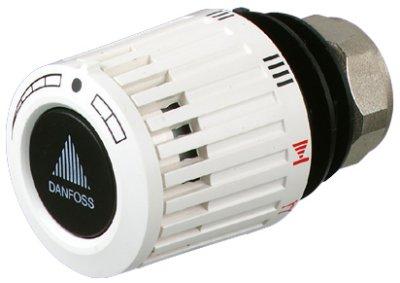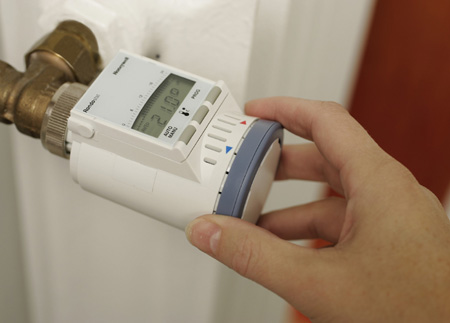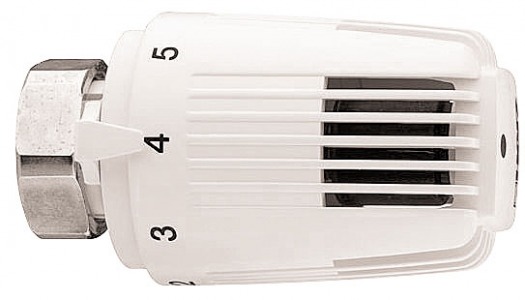Installing a thermostat on a heating radiator
By means of temperature control equipment it is possible to create the most comfortable and optimal microclimate in the house during the cold season. It is often possible to observe such a picture as in some people in houses or apartments the setting of heating radiators was carried out incorrectly, they have windows or even windows open in winter. This is due to the fact that the inhabitants of these apartments or houses cannot create normal temperature conditions, not knowing how to adjust the heating radiator, and in order to restore the temperature balance, they release cold air from the street. It is for this that the installation of a thermostat on a heating radiator serves.
Types of thermostats and their principle of operation
Temperature regulators for heating batteries are of two types:
- Automatic tap for the heating battery;
- Manual regulator of the radiator temperature of the heating batteries.
Using a manual regulator, the temperature of the heating batteries is adjusted as follows:
- By turning the valve handwheel, we will activate the valve stem.
- In this case, the bore diameter of the seat will change, and its value will correspond to the temperature.
A manual thermal valve for a heating radiator also has several disadvantages:
- It is not as efficient as an automatic device;
- Its protective cap can quickly fail if it is frequently set in motion, that is, open or close the temperature controller for a heating radiator.

In the case of an automatic type regulator, the temperature valve on the radiator will work together with a component such as a thermal head on a radiator.
Thanks to the bellows, even the smallest changes in the temperature regime in the room will be recorded. In the event of a decrease in temperature, the contents of the thermal cartridge will begin to narrow, and then the valve stem will begin to retract, which will increase the flow rate of the coolant, and this, in turn, will increase the temperature in the room. If the room is excessively hot, the contents of the cylinder will begin to expand and, thus, the heat transfer of the radiators will decrease.

Types and designs of regulators
Temperature controllers for heating radiators can differ in such a criterion as the way the signal is received by the thermostatic component. Thus, the signal can come from:
- Heat carrier;
- From the air outside;
- From indoor air.
One of the first temperature regulators received a signal from the coolant, and the accuracy of its regulation ranged from 1 to 7 degrees.
However, these indicators were not enough. Control valves for heating radiators, which record the change in the temperature regime in the room, analyze the data obtained and, due to the fact that they can regulate the flow of the coolant, will automatically maintain the required temperature regime in the room. Such a thermostat for a heating battery does not require human intervention, since it is automatic.

Another model of the device, which can most quickly respond to a change in temperature, consists of elements such as a sensor and a temperature controller for the heating battery.
Elements such as a thermostat for a radiator can be divided based on their design features. Thus, a thermostat for a heating radiator can be:
- Electrically controlled;
- With direct action.
A thermostat for a heating radiator with direct action is installed in front of the battery, and it will receive a signal about a temperature change from the coolant.
How to regulate the temperature of the radiator? The temperature will be controlled by opening or closing the heating medium supply. The valve on the heating battery of a mechanical type is equipped with a special scale, which is located on its head. The numbers on this scale help to establish the required temperature regime.

The radiator regulator, the instruction of which is mandatory for study, with electric control, is divided into two subcategories:
- Regulators that can control a pump or boiler heating;
- Regulators capable of sending a signal to valves installed in front of the radiator on the pipe. This control valve on the heating radiator, in turn, can regulate the heat supply. The valve is sized based on the size of the pipe diameter.
Location of regulators
If the radiator is not covered with anything, then the installation of thermostats on the heating batteries is better done on the heating device itself. However, if the design is equipped with a thermostat with a remote sensor, then it can be located from the valve at a distance of up to 8mm.

The thermostat can also be installed on the horizontal section of the pipe. In the place where the entrance to the heating radiator is located.
Installation of the device
Before making the installation and how to regulate the heating batteries, you will need to shut off the water supply to the heating system. After it is drained, you can proceed to such a stage as installing taps on heating batteries:
- It is necessary to cut the pipes at some distance from the battery, then disconnect them.
- Dismantle the crane if it was installed before the battery.
- From valves of the shut-off type and thermostatic type, it is necessary to disconnect the shanks, and then wrap them in the radiator plugs.
- Next, you need to assemble the harness and install it in the place that you have chosen.
- Installing a thermal head on a heating radiator will end up connecting horizontal wiring pipes. These pipes come with piping from the riser itself.
Customization
How to properly regulate radiators? When setting up devices for temperature control, you must first of all follow the instructions from the manufacturer of these devices. Such instructions will indicate both their technical characteristics and other parameters, as well as recommendations for their installation and configuration.
To adjust the heating radiators more accurately, it is necessary to close all windows and doors in order to reduce heat leakage from the room.
It is best to install a thermometer in the room to measure the room temperature. The valve must be opened all the way and the air in the room will begin to heat up. As soon as the thermometer shows that the temperature has increased by 5-7 degrees, the valve must be closed. After the sound of water is heard and the valve heats up, it will be necessary to remember the position of the head. Thus, it will be possible to adjust the control equipment in an independent way, such operations as adding or removing the radiator.
